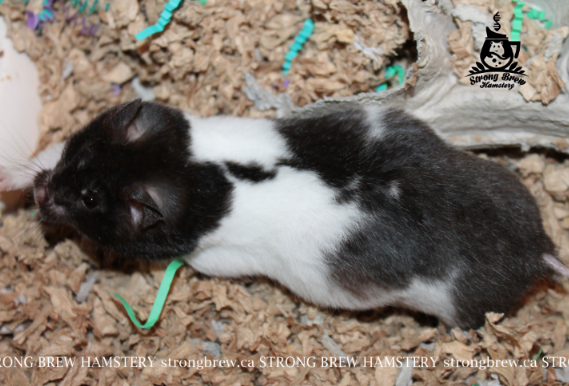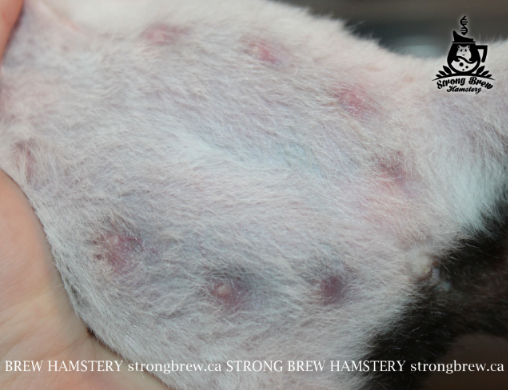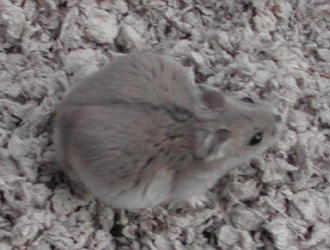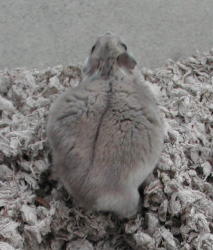Crash Course on Accidental Pregnancies
If you believe your hamster might be pregnant, please read through the information below. It will guide you through important developments, signs, and steps to take throughout the pregnancy and pup bearing. Please bear in mind that Hamster Hideout does not encourage deliberate and unethical, irresponsible breeding. Please use this guide in the cases of missexed hamsters, escaped, or otherwise. Breeding intentionally and unethically can seriously hurt your hamsters and their offspring, and bring more unwanted animals into the world. This guide will cover mostly Syrian pregnancies but will hopefully be expanded to include other species.
To note, the following has been posted with moderator permission.
Terms to know
Pups – Hamster babies are called pups.
Pinkies – This refers to the stage where the pups are only pink. Some may also call these jellybeans.
Pigment – Splotches of colour appearing on the skin.
Litter – A mother hamster’s group of babies.
Gestation – How long a hamster is pregnant for – how long the babies take to develop (ie. a human woman is 9mo).
Heat – The time when a female hamster is receptive to mating.
Cull/ing – Mother hamsters will kill and eat their offspring if they feel threatened. This is normal, and you should not intervene.
Signs of a Pregnant Hamster
Many signs that people rely on when “diagnosing” pregnancy are simply things that most hamsters in general exhibit. While a pregnant hamster will definitely nest more, hoard more, and act crazier than usual, it’s hard to know, especially when you’ve just brought home your hamster, if this is out of the ordinary for her.
Syrians have a gestation of 16 days – not really anymore. Many sites will say 16-18 days but that’s not correct – they are fairly bang on 16 days. I usually find that you can really tell a hamster is pregnant by about day ten. Their hips begin to swell and they do look pear shaped. The bulges rise above their body, giving them a rather lumpy look. The nipples will also begin to swell and pucker. Please keep in mind that many Syrians, especially short hair Syrians, will have visible FLAT nipples all the time. When they are pregnant their nipples will begin pucker, much like human ones. This is usually a sure fire sign a female is only a few days away from birthing.

A female Syrian exhibiting the “hip swell”. The pups are equal on both sides, and look like she has saddlebags. It is not an “all around” fat.

The same female with puckered nipples. While they are visible, especially the nipple closest to the bottom of the photo, is popped up and puckered.
Lead up to birth
Ensuring your pregnant hamster has a well-balanced diet is essential. A pregnant hamster will need a higher protein diet than usual, but DON’T overdo it. The problem with feeding too much protein means that the pups develop too much in the womb. This can make birthing difficult. A slight increase in protein will help the pups develop normally and keep mum in good condition. Once the pups have been born is the best time to really increase the protein.
Suggestions for protein increase:
-
Chicken
-
Mealworms
-
Esbilac/KMR
Mum will appreciate treats like egg and tofu too but please be aware these will not suffice as protein supplements, as likely they are a lower protein level than your mix. Fresh veggies and fruits are great for vitamins and minerals.
- Other things we ensure of are:
- The cage is cleaned three days prior to birth
- Any ramps, other stories, lofts, tubes are removed (basically anywhere you wouldn’t want a pup to get stuck)
- Sand baths and litter are removed
- The wheel is removed
This ensures that the pups have a safe place to grow up in.
After they’re born
Unlike rats and mice, hamsters will cull their young if they feel stressed our disturbed. Often, a pregnant hamster will groom quite a lot and pace leading up to birth. First time mothers will also appear a bit scatter brained and may even leave newborns all over the cage. Do not try to interfere or handle the pups. Your interference may cause her to turn on her babies.
Pups are usually born late at night, but sometimes they may come during the day. You can drape a towel or blanket over the side of the cage where she has nested. Then simply leave her be. Only go into the cage to fill water and food. Now is when you can begin giving lots of supplements. We often add esbilac to some powdered porridge and stir it with water.
Don’t try to peek into the nest, and don’t take pictures. All these things can cause stress to your mother hamster. Not all mums are the same, but in general please do not try to disturb them! We often advise not to count the babies - that way, if there are less pups than the day before, you don't feel upset. These things do happen, despite our best practices.
At about five days the pups will begin to get pigment. Eight days, they will start eating food mum brings back and mum’s faeces. This is normal, and helps them to gain good gut flora. We also begin to place chopped cucumber near the nest for hydration. Once they are around ten days, the pups will begin escaping the nest (or at least trying to). After fourteen days, they will be zooming around and keeping mum on her toes. Their eyes will open anywhere from fourteen to eighteen days. Once their eyes are open, it is safe to touch them.
Handling and cleaning the cage
Pups are very spring loaded. Only handle them over something soft in case they ping pong out of your hand. Always make sure the mother is alright with you handling them first. When they are just opening their eyes, it is best to scoop them into your palms.
After their eyes are open, you will want to clean their cage. Prepare two bins – one for mum to sit in with a bowl of food, and one for babies (a carrier works fine for this too). Place mum alone with her food dish (you could also give her a wheel but only in this bin). Place pups in the other bin (or carrier). Clean the cage, leaving as much of the nest in tact as possible (use your own judgement about if it needs to be removed, possibly the bottom).
Once the cage is cleaned, return mum to the fresh cage and let her explore. You can take this opportunity to handle the babies individually and try to sex them. See below for pictures of male vs. female baby Syrians.
After this, place them back with mum in the cage. You’ve done your first clean out! We often handle the pups multiple times a day, and use a snuggle sack for them as well. It is important to keep supplementing their diet with porridges, baby food, chicken, etc.
Weaning
Syrian pups are weaned at 3wks of age. Sometimes the mother will continue to nurse. You may notice that mum is pawing at her pups, essentially she is telling them to go away. Pups at this stage will also tussle a lot with their siblings. This is normal. Never separate baby Syrians from their siblings or mother until after four weeks (explained more below).
Separation
Occasionally, mum will get very restless and stop being nice to her pups. In this case, it is advisable to remove earlier (we’ve removed a mum at 25 days before). Otherwise, mum stays with her pups until 28 days. Then we either remove mum to another bin, or remove the babies to another bin. This is the time that you will want to split the sexes. Males go in one bin, females in another. If you are in doubt, always place the unknown pup with the males. The reason being, it’s better to have one pregnant female in with a bunch of males, than ALL the other females pregnant because they were left with a brother.
Now is the time we give our pups wheels. We also double check that evening to make sure sexes are correct.
We slowly remove trouble makers from the ‘pack’, usually as they reach closer to six weeks. You can tell the difference between play fighting and real fighting when the little peeps they make sound more like pained squeaks. Bites will initially go to the ears, rump and face. Please be on the lookout for these signs once 5wks have passed.
Rehoming
Rehoming privately is always a great option, but sometimes it isn’t feasible. If your hamster came home pregnant from the shop, often times the shop will want the babies back to sell. What you can do is try to rehome as many privately as possible. Reach out to friends and relatives to see if they want hamsters. You can post on the forum or in your local ads. Please remember to advise individuals on proper hamster care and screen adopters to ensure they are suitable. Always include an adoption fee of $5 or more. This makes sure you only get serious adopters, and ones who have good intentions for the pup.
Hamsters should go to new homes only once they have reached 6wks of age. Send them with some familiar bedding and a bit of the food they are used to.
Hand raising
Often times there will be a runt in the litter or a pup will be rejected from the nest. Instead of placing the pup back, it’s better to try and lure the mum out towards that pup. If she collects that little one – great! Sometimes though hand raising may be necessary. It is pretty much unheard of for pups under about eight days to survive being hand raised, but if you feel confident it is something you can try. Be prepared for heartache. I know that sounds pessimistic but hamsters are not great candidates for hand raising.
- You will need:
- Heating pad
- Cotton balls
- Paint brush or make up sponge
- Esbilac or KMR
It is important to offer feeding every 1-2hrs. Follow the directions for the KMR or Esbilac and use either a paint brush or sponge to administer the milk. This will help to make sure the pup does not aspirate the milk. Once feeding is done, you will need to stimulate the bowels. Repeat for all pups, and keep warm and covered with a heating pad or hot water bottle on low.
Complications
Sometimes pregnancies may come with complications. Complications are common with hybrids, one of the reasons why they are quite high risk.
Look for these signs during/post labour:
- Audible noises (like screaming or screeching) from the mum
- Excessive amounts of blood
Those mean you should rush mum to the vet. She may have a pup stuck and might need an emergency c-section. It is very uncommon for mother hamsters to accept their young (if they are still viable) after surgery.
After pups have been born look for these signs:
- Blueish tint to nipples
- Abdominal swelling or pus from the vents (vulva)
Either one of these symptoms mean a vet visit. There are other complications as well, but these are simply some of the main ones.






































